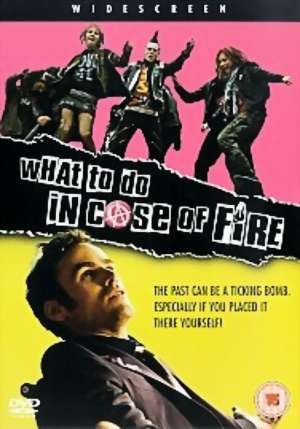- What to Do in Case of Fire?
Infobox Film
name = What to Do in Case of Fire?

caption =VHS cover
imdb_id = 0207198
writer =Stefan Dähnert Anne Wild
starring =Til Schweiger Martin Feifel
director =Gregor Schnitzler
producer =Jakob Claussen Andrea Wilson Thomas Wöbke
cinematography =Andreas Berger
editing =Hansjörg Weißbrich
distributor =Columbia Pictures
released =2001 (Germany )
runtime = 101 min.
language = German
tagline = Nothing can burn you like the past.
budget =
website = http://www.sonypictures.de/filme/was%2Dtun%2Dwenns%2Dbrennt.de
music =Stephan Zacharias |What to Do in Case of Fire? ("Was tun, wenn's brennt?" in German) is a German film directed by
Gregor Schnitzler . It premiered inNovember 2001 at the German film festival KinofestLünen and was released to theaters in 2002. Part comedy, part action and part drama, the movie is set in contemporaryBerlin and stars German action starTil Schweiger .The film received mixed reviews, earning 52 percent favorable ratings from critics cited on
Rotten Tomatoes .Plot
Set in Berlin, the film opens in
1987 to show a group of radicals battling police but soon moves to the modern day to present the same radical characters brought together once more by an act they carried out in their anti-establishment heyday.In 1987, the main characters of the film are anarchists
squatting in an abandoned building inKreuzberg and makingpropaganda films. In one of these films, they demonstrate how to make a homemade bomb out of apressure cooker and chemicals available over the counter, and they plant the bomb in a vacant villa inGrunewald . However, the timer sticks, and the bomb does not go off until 12 years later, when it is jostled by areal estate broker and a potential buyer. They are injured in the blast, and the police are under pressure to hunt down the "terrorists."Two of the original anarchists, Tim (Schweiger) and Hotte (Martin Feifel), still live in the original building and engage in anti-police
graffiti , anti-gentrification protests and pettytheft . The current owner of the building, anouveau riche Turk named Bülent, cannot evict them, because Hotte isdisabled , having lost his legs. (It is later revealed that they were crushed by awater cannon during ariot .) While Tim is out, the police raid the building in a sweep for clues to the bombing and confiscate their cache of old films, including the incriminating bomb-making film. They cart the films off to the fortresslike police headquarters, a formerPrussia nmilitary barracks . One by one, Tim and Hotte visit the former members of their group to warn them of the bust. They are distressed by the news, having gone on with their lives: Nele (Nadja Uhl) is a single mother of two young children; "Terror" (Matthias Matschke) is anattorney ; Maik (Sebastian Blomberg) runs anadvertising agency that exploits radical imagery; and Flo (Doris Schretzmayer), Tim's former lover, has evidently gonebourgeois , although her circumstances are never fully explained, and is about to get married. They balk when Tim and Hotte propose breaking into the police headquarters and destroying the evidence, but Terror's counter-suggestion that they should turn themselves in is met with even stronger disagreement, and finally the former radicals devise the plan of infiltrating the headquarters by pretending to be a television news crew.A rift within the police department makes their plan possible: Manowsky (Klaus Löwitsch), an
old school Berlin cop, wants to use aggressive tactics and avoid press coverage, while Henkel (Devid Striesow), a technocrat fromBonn , prefers more modern, less intrusive methods and is eager to earn goodpublic relations for the department. Henkel gives the "TV crew" a tour of the police headquarters, including the evidence room where the films are stashed. Manowsky interrupts the tour, and the former radicals barely manage to slip away.To destroy the films, the radicals decide to smuggle a second homemade bomb into the evidence room as a
Trojan horse : all the evidence is storedalphabetically according to the street where it was found, so they need only plant the bomb in a suspicious-looking crate in their old building and entice the police into picking it up. What the other radicals do not know is that Hotte intends to smuggle himself into the evidence room inside the crate along with the bomb, to make sure it's placed correctly. Hotte, without his wheelchair (he uses a dolly), is trapped in the evidence room when the emergency exit door is jammed. Frantically, he uses the phone in the room to call his compatriots, but they are all away from their phones. In desperation he calls Bülent, who at that moment is trying to talk Tim into abandoning their apartment and accepting a payoff for their few remaining goods. Tim rushes to Hotte's aid. The others eventually get Hotte's message and come to rescue him as well, but meanwhile, Manowsky intercepts Hotte and Tim in the evidence room. After a taunting lecture on their inability to let go of past ideals, Manowsky prepares to arrest the two, but the others arrive just in time to distract him. Tim seizes Manowsky'shandcuffs and shackles him to the evidence cage. He threatens to leave the bomb in Manowsky's lap, but the others persuade him not to commit outrightmurder . Tim tosses Manowsky the handcuff keys, and the radicals flee as an alarm sounds.Pursued by police through the headquarters, the former radicals stumble upon a water cannon and use it to drive back the police and escape. As Manowsky and Henkel observe their flight, Henkel confidently predicts that the evidence will lead to their capture. However, Manowskyndash moved by the radicals' compassion, by his annoyance with Henkel and by reflection on his own long-held idealsndash has left the bomb in the evidence room, and it destroys the incriminating films.
The film contains mild nudity, mild drug use, and mature language.
External links
*imdb title|id=0207198|title=Was tun, wenn's brennt?
Wikimedia Foundation. 2010.
